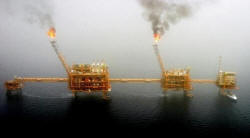|
Oil prices slip as
persistent fuel glut returns to focus
 Send a link to a friend
Send a link to a friend
 [November 11, 2016]
By Sabina Zawadzki [November 11, 2016]
By Sabina Zawadzki
LONDON
(Reuters) - Oil prices slipped on Friday as the market refocused on a
persistent fuel supply overhang that is not expected to abate unless
OPEC and other producers cut their output significantly.
International Brent crude futures traded at $45.24 per barrel at
1145 GMT, down 60 cents from their last close.
U.S. West Texas Intermediate (WTI) crude futures were trading 66 cents
lower at $44.00 per barrel.
Benchmark crude futures contracts have in the past week wiped out the
gains made since the end of September when the Organization of the
Petroleum Exporting Countries said it would agree to cut oil production
to shore up persistently low prices.
While investors were always skeptical that a deal to cut or freeze oil
output could be reached and implemented at an OPEC meeting on Nov. 30,
an increasing amount of data has underscored a global skew towards
oversupply.

OPEC reported on Friday an increase in its output to another record
high, pointing to an even larger surplus on the market next year. It
said it pumped 33.64 million barrels per day (bpd) last month, up
240,000 bpd from September.
That means the cartel, beset by geopolitical squabbles amongst some of
its 14 member states, would have to cut up to a million bpd if it makes
good on its promise to reduce its output to between 32.50 million bpd
and 33.0 million bpd.
Meanwhile, the International Energy Agency (IEA) said the supply
overhang could run into a third year in 2017, should OPEC fail to act.
"Oil markets are increasingly reflecting growing consensus that the
persistent oversupply seen throughout 2016 will carry on into 2017,"
analysts at JBC Energy wrote.
"We would actually go a step further, as while 2016 has seen a
significant improvement from 2015 with easing oversupplies, 2017 will be
worse again barring massive outages or OPEC action."
[to top of second column] |

Gas flares from an oil production platform at the Soroush oil fields
in the Persian Gulf, south of the capital Tehran, July 25, 2005.
REUTERS/Raheb Homavandi/File Photo

In its monthly oil market report, the IEA said global supply rose by
800,000 bpd in October to 97.8 million bpd, led by record OPEC output
and rising production from non-OPEC members such as Russia, Brazil,
Canada and Kazakhstan.
Nigeria is working out new oil and gas policies to attract more private
investors and boost crude production by 500,000 bpd by 2020, state firm
NNPC said on Thursday.
The IEA kept its demand growth forecast for 2016 at 1.2 million bpd and
expects consumption to increase at the same pace next year, having
slowed from a five-year peak of 1.8 million bpd in 2015. OPEC had a
similar global demand growth forecast for next year of 1.15 million bpd.
Beyond oversupply, a surging dollar following the initial shock of
Donald Trump's U.S. presidential election win also put pressure on
prices, traders said. The dollar was on course on Friday for its
strongest week in a year.
Because oil and refined products are traded in dollars, their import
costs rise for countries using other currencies, potentially crimping
demand.
(Reporting by Sabina Zawadzki; Additional reporting by Henning Gloystein
in Singapore; Editing by Dale Hudson/Ruth Pitchford)
[© 2016 Thomson Reuters. All rights
reserved.] Copyright 2016 Reuters. All rights reserved. This material may not be published,
broadcast, rewritten or redistributed.

|